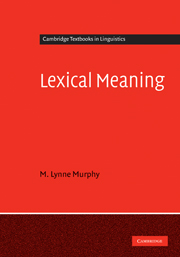Book contents
- Frontmatter
- Contents
- List of figures
- Preface: using this book
- Acknowledgments
- Typographical conventions
- Part I Meaning and the lexicon
- 1 The lexicon – some preliminaries
- 2 What do we mean by meaning?
- 3 Components and prototypes
- 4 Modern componential approaches – and some alternatives
- Part II Relations among words and senses
- Part III Word classes and semantic types
- References
- Index
1 - The lexicon – some preliminaries
from Part I - Meaning and the lexicon
Published online by Cambridge University Press: 05 June 2012
- Frontmatter
- Contents
- List of figures
- Preface: using this book
- Acknowledgments
- Typographical conventions
- Part I Meaning and the lexicon
- 1 The lexicon – some preliminaries
- 2 What do we mean by meaning?
- 3 Components and prototypes
- 4 Modern componential approaches – and some alternatives
- Part II Relations among words and senses
- Part III Word classes and semantic types
- References
- Index
Summary
Key words:
lexical semantics, lexicon, lexis, mental lexicon, lexeme, conventional, (non-)compositional, arbitrary, lexical unit, word, idiom, collocation, open/closed class, lexicography, corpus, native speaker intuition
Overview
In order to set the stage for exploring lexical semantics, this chapter defines basic terms and ideas in the field, particularly the notions of lexicon, lexeme, and word. It then describes and evaluates four methods for investigating the lexicon: dictionaries, corpora, intuition, and experimentation.
- Type
- Chapter
- Information
- Lexical Meaning , pp. 3 - 28Publisher: Cambridge University PressPrint publication year: 2010

